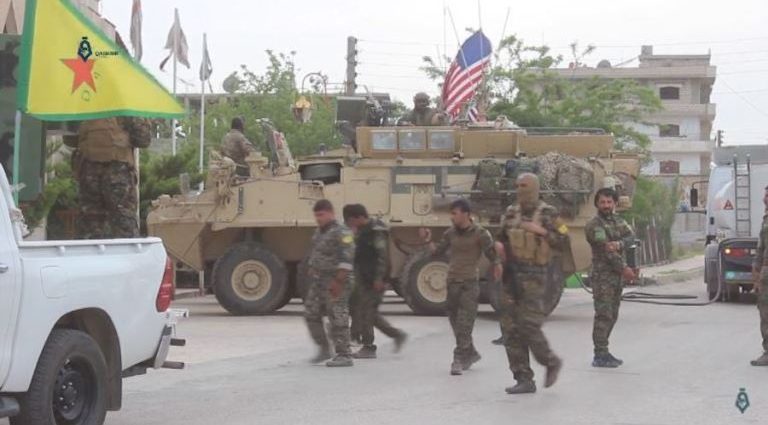
A recent uptick in attacks against US troops in Syria has raised questions over the effectiveness of the Joe Biden administration’s Iran policy as well as concerns that a new conflict could erupt in the region.
While attacks have significantly increased over the past two years, the recent spate is particularly troubling. A series of tit-for-tat retaliations between US forces and Iranian-backed militias was sparked by a March 23 drone attack on a facility used by the US military in Hasakah, in northeastern Syria.
An American contractor was killed and several US troops were injured in the Hasakah attack. The incident prompted Washington to carry out a series of deadly strikes against Iran-backed militias, who then responded by carrying out attacks against US-backed bases in Syria.
Unlike previous incidents, the drone assault recorded more casualties than in the past two years, which reached 10 in total. These developments strongly indicate that Washington’s soft response to the Iranian-backed militias involved is only leading to further and more deadly aggression.
Indeed, Pentagon officials told Voice of America last month that the recent attacks had caused traumatic brain injuries in 23 military personnel.
The US is believed to have around 900 soldiers deployed in Syria, where it has long been committed to the overthrow of the government of Bashar al-Assad. These troops mostly support the Kurdish-led Syrian Democratic Forces in their fight against the remnants of Islamic State (ISIS), preventing the terrorist group from recapturing territory.
However, not all American troops are stationed inside the Kurdish-controlled region. Washington also has a relatively significant military presence in al-Tanf, which is located on a strategic road connecting Tehran to Lebanon via Iraq and Syria. The base is widely seen as part of the larger US strategy to contain Iran’s military reach in the region.
In the 27 months since President Joe Biden took office, at least 84 attacks were reported on positions hosting US troops or contractors in Iraq and Syria. That translates to a little more than three attacks a month, an unprecedented rate in the history of US operations in Syria.
Most of these attacks were carried out against US locations in northeastern Syria, where operations against ISIS are centered. Despite its importance for Iran, the al-Tanf base came second. Notably, the drones used in the Syria attacks were similar to those used against US air bases in Iraq.
This strongly indicates that Iranian-backed militias are likely behind the drone incursions in both countries, including the majority of unclaimed attacks.
While expelling US forces from Syria seems to be the common goal, the triggers that initiated the assaults appear to vary. For example, attacks in January are believed to have been motivated by the desire of Iranian-backed factions to commemorate the third anniversary of the death of Qasem Soleimani, the senior Tehran military official killed by an American air strike in January 2020.
Other attacks are suspected to be linked to nuclear negotiations between the US and Iran. Several diplomatic sources said some attacks were aimed at influencing negotiations, while others were arranged by hardliners to spoil the talks altogether.
Meanwhile, US and Israeli officials have said Iran-backed groups in Syria, in addition to launching assaults in response to US air strikes, are also attacking American forces in retaliation against Israeli air strikes.
Lacking the capacity or willingness to attack Israel directly, Iran-backed fighters have frequently responded by targeting US forces instead, as they are considered easier and less risky. For example, two of last month’s attacks took place the day after suspected Israeli air strikes hit Iranian-backed factions in Syria on March 12 and March 22.
US foreign policy in question
But these triggers are not new and cannot alone explain the motivation for the recent uptick in attacks against US forces. The answer might lie in America’s foreign policy under the Biden administration.
The White House’s decisions to withdraw from Afghanistan and end the US combat mission in Iraq have emboldened Iranian-backed militias to test Washington’s boundaries in both Syria and Iraq. More important, the US has refrained from aggressively retaliating against those involved in the attacks against its bases.
So far, the Biden administration has only launched four rounds of retaliatory air strikes in response to the 84 attacks that occurred in Iraq and Syria. These retaliations were largely limited to targeting infrastructure belonging to Iranian-backed groups instead of assertively punishing the groups responsible.
The limited costs that the US has imposed on Iranian-aligned aggressors has not only emboldened attacks but also made American troops low-hanging fruit. In congressional hearings last month, Republican lawmakers accused the Biden administration of being soft on Tehran and failing to protect American forces.
Washington’s desire to limit the risk of escalation with Iran is understandable. However, by failing to enforce a sufficient deterrence strategy the US has increased the risks that American soldiers in Syria are facing.
More important, despite a desire not to trigger an all-out confrontation, a miscalculation that could lead to a severe escalation is possible. And that is enough to keep everyone involved on edge.
This article was provided by Syndication Bureau, which holds copyright.
Follow Haid Haid on Twitter @HaidHaid22.

